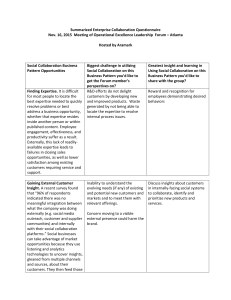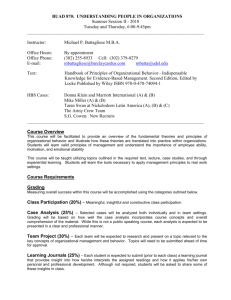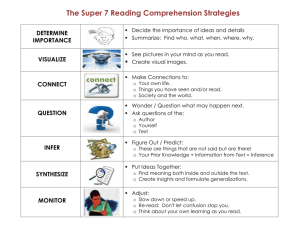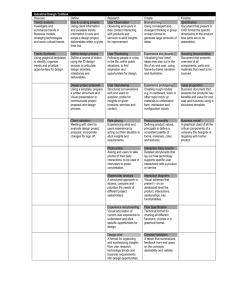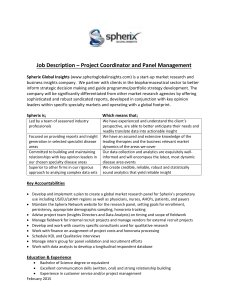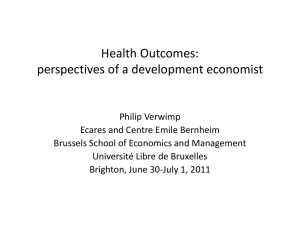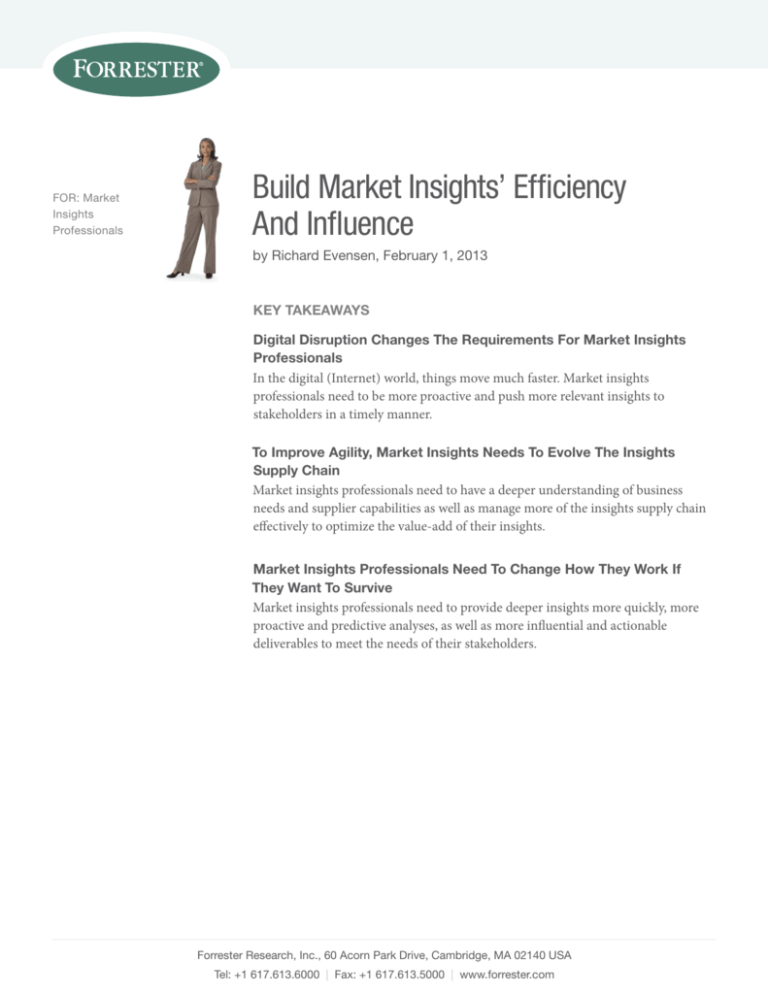
For: Market
Insights
Professionals
Build Market Insights’ Efficiency
And Influence
by richard evensen, February 1, 2013
key TakeaWays
digital disruption Changes The Requirements For Market insights
professionals
In the digital (Internet) world, things move much faster. Market insights
professionals need to be more proactive and push more relevant insights to
stakeholders in a timely manner.
To improve agility, Market insights Needs To evolve The insights
supply Chain
Market insights professionals need to have a deeper understanding of business
needs and supplier capabilities as well as manage more of the insights supply chain
effectively to optimize the value-add of their insights.
Market insights professionals Need To Change how They Work if
They Want To survive
Market insights professionals need to provide deeper insights more quickly, more
proactive and predictive analyses, as well as more influential and actionable
deliverables to meet the needs of their stakeholders.
Forrester research, Inc., 60 acorn Park Drive, Cambridge, Ma 02140 usa
tel: +1 617.613.6000 | Fax: +1 617.613.5000 | www.forrester.com
For Market Insights Professionals
February 1, 2013
Build Market Insights’ Efficiency And Influence
Processes: The Market Insights Optimization Playbook
by Richard Evensen
with Reineke Reitsma, Ryan Morrill, and Douglas Roberge
Why Read This Report
Digital disruption has created an environment in which customer and competitive change are happening at
much faster rates, leading stakeholders to increase their demands for more innovative, agile, and deep insights.
This, in turn, is forcing market insights to evolve and significantly change how it works. At a high level, market
insights must become more proactive, predictive, and agile; work more effectively with too little (incomplete)
or too much (big) data; greatly improve the integration of data and insights; impress stakeholders with
deliverables; and influence change to maximize the ROI of insights. In this report, Forrester drills down into
how market insights must change. We’ll describe what an evolved market insights information supply chain
looks like and show you what process changes need to happen at each of three key phases in the insights value
chain — insights capture, insights analysis, and insights delivery and activation — to allow market insights to
become more efficient and influential in the age of digital disruption.
Table Of Contents
Notes & Resources
2 Digital Disruption Changes Everything For
Market Insights
In developing this report, Forrester drew on
a wealth of analyst experience, insight, and
research through a review of existing best
practices, interviews, analyst advisory, and
inquiry discussions with market insights
professionals and stakeholders.
2 The Market Insights Information Supply
Chain Must Evolve
5 Market Insights Needs To Optimize Its
Insights Fulfillment
Insights Capture Must Be More Focused And
Holistic
Insights Analysis Must Be More Proactive And
Innovative
Insights Delivery And Activation Must Be More
Engaged And Influential
Related Research Documents
The Marketing Of Market Insights: How To
Build Internal Relationships And Influence
February 22, 2012
Market Insights Must Add Value And Evolve
March 14, 2011
Recommendations
12 Focus Market Insights In The Right Direction
Notes & Resources
© 2013, Forrester Research, Inc. All rights reserved. Unauthorized reproduction is strictly prohibited. Information is based on best available
resources. Opinions reflect judgment at the time and are subject to change. Forrester®, Technographics®, Forrester Wave, RoleView, TechRadar,
and Total Economic Impact are trademarks of Forrester Research, Inc. All other trademarks are the property of their respective companies. To
purchase reprints of this document, please email clientsupport@forrester.com. For additional information, go to www.forrester.com.
For Market Insights Professionals
2
Build Market Insights’ Efficiency And Influence
digital disruption changes everything for market insights
In 2011, Forrester wrote that: “Digital disruption is unlike any other disruptive force you’ve read
about . . . When it’s your turn, digital disruption will happen so fast and with such a completely
devastating effect that it will feel like it was led by a global conspiracy, a junta of disruptors who
shared secrets, pooled their digital resources, and plotted their overthrow of the establishment.”1
As the primary department in the company focused on capturing external insights about customers,
competitors, and the market, market insights has responsibility for maintaining a “disruption radar.”
This means that market insights professionals need to learn to:
■ Identify disruptions early or before they happen. Market insights professionals need to know
what to look for, be on the alert for potential triggers of change, and have a lot more eyes and
ears helping them, as disruptions can come from the market, competitors, the ecosystem, and
even their customers.
■ Proactively alert stakeholders to potential disruptions and their impact. Market researchers
like to deal with “what is” rather than “what if ”; they want to have enough data on hand to
make statistically valid statements.2 Unfortunately, because of the swiftness of disruptions,
companies no longer always have the time to get all the data before they make decisions. To
ensure resiliency in the face of disruption, market insights professionals must maintain a rich
knowledge base and know where to get quick access to needed insights.
■ Guide stakeholders in making insights-based decisions, rather than gut-based ones.
Traditionally, market researchers delivered the data and were done, often leaving a gap between
“what is,” “what it means,” and “what should we do.” To ensure the actionability of insights —
and gain proof points of insights’ value — market insights teams need to partner with their
stakeholders to ensure that their insights are acted upon and not just put in the recycling bin.
The market insights information supply chain must evolve
It’s important for market insights professionals to realize that they are the fulfillment stage in a larger
information supply chain. As with any other supply chain optimization process, this means that
market insights professionals need to (see Figure 1):
■ Improve their visibility into demand flow. Instead of waiting for research requests, market
insights teams need to engage stakeholders proactively to identify key business and stakeholder
goals, then identify and guide the relevant research and insights that will support these goals.
This requires improving stakeholder relationships and influence.3 The benefit is that greater
visibility into demand also means an improved ability to align budget, resources, research supply,
and plans with business needs.
© 2013, Forrester Research, Inc. Reproduction Prohibited
February 1, 2013
For Market Insights Professionals
3
Build Market Insights’ Efficiency And Influence
■ Improve their control over supply flow. Crucial to market insights’ ability to become a more
agile, innovative, and high-value partner is its ability to improve its own supply chain.4 This
requires beefing up the availability of and access to insights as well as partnering more with
suppliers to help push relevant insights into the organization and gain the lead time required to
proactively capture the needed data and insights.
■ Improve their fulfillment time and quality. Market insights needs to own the information
supply chain — from ordering to implementation. In research terms, this includes the capture,
analysis, and delivery of insights — as well as their activation. The latter point is crucial, as
insights have no value if stakeholders don’t act on them.5
■ Improve their visibility into the use and impact of their insights. Automobile manufacturers
don’t just sell their cars and walk away. They track how well their cars are performing to ensure
continual improvements in product design, supplier choice, and processing as well as to gain
feedback for marketing purposes. Market insights is no different in that it must track the impact
of its insights to know what performed well in order to identify where it should focus its portfolio
and efforts as well as to gain proof points to use when marketing the value of market insights.
© 2013, Forrester Research, Inc. Reproduction Prohibited
February 1, 2013
For Market Insights Professionals
4
Build Market Insights’ Efficiency And Influence
Figure 1 Evolution Requires Better Visibility Into And Control Of The Insights Supply Chain
Start
Business
goals
Strategy
assessment
Stakeholder
goals
Strategy
impact
Demand flow
Stakeholders
Stakeholder
info. needs
Research
needs
Insights
availability
Knowledge
and profiles
Insights fulfillment
Insights Insights Insights
capture analytics delivery
Insights fulfillment
Strategy
integration
Strategy
creation
Postmortems
Gap
analysis
Supply flow
Suppliers
Data and
insights
Enrichment
plan
Sources
Insights’
needs
Start
85641
© 2013, Forrester Research, Inc. Reproduction Prohibited
Source: Forrester Research, Inc.
February 1, 2013
For Market Insights Professionals
5
Build Market Insights’ Efficiency And Influence
Market Insights Needs To Optimize its Insights Fulfillment
In the past, if you ordered a product, it could take many months to get from its point of creation
to its final sales destination. Fast-forward to 2013 and we now expect two-day delivery or we’ll go
elsewhere. The takeaway here is not about delivery time but about realizing the massive changes that
had to happen at each step in the product fulfillment (supply) chain to make this possible.
Market insights professionals looking to optimize the delivery of their insights must optimize their
fulfillment. More precisely, this means that (see Figure 2):
■ Insights capture needs to become more holistic and focused. Monolithic data feeds are no
longer enough. Market insights needs to tap inputs across its entire ecosystem and get needed
information sooner.6 Inputs — including quantitative and qualitative data, as well as refined
insights — will need to be as automated as possible, properly organized, integrated, and easily
accessible to ensure agility and efficiency.
■ Insights analysis needs to be more proactive and innovative. Market insights professionals
no longer have the time to swim in the data and see what they find. To optimize this step in the
information supply chain requires improved data science — and art: hypothesis-based research
and analysis, better quantitative and predictive models, and the ability to see patterns in the data
and information that others don’t.
■ Insights delivery and activation needs to be more engaged and influential. Insights have
no value unless they are acted upon. This needs to become market insights’ mantra. To ensure
insights activation, market insights professionals need to improve their understanding of, and
influence with, key stakeholders. This means becoming more engaged with stakeholders in their
strategic decision-making and following insights from delivery to implementation and impact.
© 2013, Forrester Research, Inc. Reproduction Prohibited
February 1, 2013
For Market Insights Professionals
6
Build Market Insights’ Efficiency And Influence
Figure 2 Evolved Market Insights Teams Have An Enriched Insights Fulfillment Chain
Stakeholder and
business empowerment
Insights delivery and
activation
Insights analysis
Insights capture
Stakeholder and
business understanding
Engaged and
influential
Proactive and
innovative
Holistic and
focused
85641
Source: Forrester Research, Inc.
Insights Capture Must Be More Focused And Holistic
There is a tendency among some market researchers to “boil the ocean” — i.e., to try to capture
all possible data and then see what nuggets of insight they can find. Just like (literally) boiling an
ocean, this is very labor-intensive and time-consuming — and it’s impossible for market insights
professionals who are already overworked.
Forrester believes that market insights professionals need to change how they look for and capture
insights. By adopting a step-by-step, focused process, market insights professionals can become more
efficient and effective at capturing truly high-value/high-impact insights. To do this (see Figure 3):
■ Start with what stakeholders want, not what you have. Because many market researchers are
reactive and working under extreme time pressure as a result, there is a tendency to give
stakeholders whatever data/insights are on hand rather than what they really want. This can both
overload and underwhelm stakeholders, giving them the impression that market insights is a
low-value information supplier rather than a high-value insights partner. For Intuit, aligning the
research portfolio to stakeholder initiatives was one of the first priorities in empowering the team.
© 2013, Forrester Research, Inc. Reproduction Prohibited
February 1, 2013
For Market Insights Professionals
7
Build Market Insights’ Efficiency And Influence
■ Don’t over-engineer things. Swinging too far in the other direction and doing a full-blown
project for every stakeholder request is also problematic. First, it greatly reduces time-toinsights; second, it reduces budget and resource availability, potentially unnecessarily. Instead,
assess on-hand and easily available information by tapping business partners, industry
organizations, and analyst firms, and see if these insights are sufficient for stakeholders. Market
insights professionals at BlackBerry and CSC run stakeholder queries by a variety of analysts
and then synthesize the results, often saving stakeholders months of waiting and the insights
team many precious hours of effort.
■ Prioritize net-new insights requirements. Not all insights have the same value to the
business or to stakeholders. Prior to investing your precious budget and time in a project,
talk to stakeholders about the intended use of the insights.7 For which workflows or strategy
developments are they needed? Which metrics could be affected — and by how much? Then, do
a projected ROI analysis to determine how important these insights are.8
■ Hypothesize what is really needed. Often, market insights professionals will send out requests
for proposals (RFPs) that ask for tons of data and insights when they are simply trying to
determine whether competitor X is doing Y. The result is a much more costly and timeconsuming project than necessary. Instead, focus on what you’re trying to prove or disprove,
identify the key types of data and insights that would help you do this, and then focus on how
best to capture this information.9
■ Align insights with optimal information sources. Many sources are available to market
insights professionals.10 At this stage, align the types of insights that you are looking for with the
optimal sources of these insights — where optimal is defined in terms of the cost and time to
obtain insights and the quality and depth that the sources typically provide. Avoid the tendency
to get multiple bids, which wastes your time and undermines your relationship with the vendors
that don’t win your business; focus instead on the partners that can best meet your needs.
■ Assess and make requests until you get what you need. There are enough cases of market
insights teams being frustrated with outside vendors to reiterate the warning: Buyer beware!
If you use an outside vendor to obtain targeted insights, don’t be hands-off. To ensure optimal
results, one market insights professional had the vendor provide “insights to date” at 25%, 50%,
and 75% of project completion. It’s your responsibility to ensure that you get the insights you
need, so push for regular updates and adjust criteria as needed to optimize the final deliverables.
■ Cross-check results against other information sources. Prior to taking a firm stand that
the insights you have are accurate, test them against other relevant sources of data, especially
customer feedback, competitive intelligence, transactional data, social media insights, and
even web analytics. Several market insights analysts have faced the challenge recently of social
media analytics not backing up survey data, and Forrester has heard of several situations where
© 2013, Forrester Research, Inc. Reproduction Prohibited
February 1, 2013
For Market Insights Professionals
8
Build Market Insights’ Efficiency And Influence
survey data (what customers said they did) didn’t line up with behavioral data (what actually
happened). Not being aware of — and solving for — the differences among sources can make
you vulnerable and lose credibility if these other sources refute your findings. By contrast,
integrating these other sources gives you a more holistic view of your topic, which can greatly
enrich your insights.11
■ Ensure stakeholders understand your insights. Don’t just hand off electronic insights
deliverables. Instead, have a conversation with the insights analytics team member(s) or
stakeholders to make sure they fully understand the insights you’re providing. If the news
is going to be bad, do as Sonja Mathews, vice president of market research and competitive
intelligence at USAA, does and give the stakeholders affected a pre-read rather than surprising
them in a larger meeting.
© 2013, Forrester Research, Inc. Reproduction Prohibited
February 1, 2013
For Market Insights Professionals
9
Build Market Insights’ Efficiency And Influence
Figure 3 How To Efficiently Capture And Process High-Value Insights
Insights capture process flow
Assess
Focus on stakeholder
needs versus
available insights.
Determine if on-hand
and easily available
insights are sufficient.
insight needs.
Hypothesize and
identify triggers to
focus on in research
requests.
Capture
Identify optimal
providers and
partner with
key source(s).
Assess insights and
request changes
until needs are met.
Optimize
Cross-check insights
against other sources.
Deliver insights to
analytics team
and/or stakeholders.
Focus Prioritize any net-new
85641
© 2013, Forrester Research, Inc. Reproduction Prohibited
Source: Forrester Research, Inc.
February 1, 2013
For Market Insights Professionals
10
Build Market Insights’ Efficiency And Influence
Insights Analysis Must Be More Proactive And Innovative
For market insights professionals to meet the needs of the business and key stakeholders in the
age of disruption, they must move beyond only explaining the past: where the company was
(benchmark reports), why something happened (deep-dive reports), and how satisfied customers
were (CSAT reports). Instead, the focus has to move increasingly toward forward-looking research:
where the company should go, what offerings it should develop, and how it can improve its
competitive advantage and meet future customer needs.
To do this, though, requires a major shift in mindset for market insights professionals and a
change in how they typically do insights analysis (see Figure 4). Forrester believes that the winning
companies (and winning market insights organizations) will be those that:
■ Have a deep understanding of their customers, competitors, and broader ecosystem. It’s
no longer enough to track what competitors did, how customers felt, and what happened in
the ecosystem. To maintain customer alignment and competitive advantage, market insights
professionals need to understand what competitors could do based on a deep understanding
of their assets, talent, capabilities, structures, processes, and cultures and what customers are
likely to do based on a deep understanding of their values, beliefs, needs, and behaviors. Further,
companies need to track potential changes across the ecosystem: the types of companies that
could move in from adjacent markets or that could use technology to become a competitive
threat or collaborator.12
■ Use insights to evaluate possible outcomes (scenarios). Instead of explaining the past, market
insights professionals need to be able to foresee possible futures. This is about analyzing
available data and insights, brainstorming with the best minds in the company and industry,
and identifying disruptive business models, potential hot offerings, and strategies before a
competitor does. Look at changes in technology and consumer preferences and do what-if
exercises to develop logical scenarios based on a deep understanding of the market. This may
not seem very innovative, but it ultimately provides the fuel for innovation!
■ Build proactive “sense and respond” mechanisms to be ready for change. Companies no longer
have the time to start the clock once competitors have announced their change or customers have
told you they’re leaving. Whatever the disruption and driver of customer change — a new product,
new competitor, new pricing model, or new way of accessing offerings (e.g., via an app) — market
insights professionals need to be ready to guide the company’s response strategies with insightsbased, not gut-based, options. This ability to “sense” sooner helps ensure that the company can
“respond” quicker.13
© 2013, Forrester Research, Inc. Reproduction Prohibited
February 1, 2013
For Market Insights Professionals
11
Build Market Insights’ Efficiency And Influence
Figure 4 Proactive Analytics Requires Improved Sourcing, Profiles, Hypotheses, And Focus
Step 1
Rich sourcing (360˚ information — external and internal)
Comprehensive profiles
Step 2
(market/ecosystem/competitive/customer )
Profile 1
Scenario 2
Profile 2
Step 3
Scenario 1
Scenario 3
Step 4
Triggers
(a, b, c, etc.)
Step 5
Information
needs
Step 6
Target
suppliers
Step 7
Monitor and adjust above as needed.
Scenario 1
Scenario 2
Scenario 3
Make sure to differentiate
by offering, industry,
country, and customer
segment (as applicable).
Source: Forrester Research, Inc.
85641
Insights Delivery And Activation Must Be More Engaged And Influential
To evolve to a more powerful and influential position and ensure that strategic decisions are
insights-based rather than gut-based, market insights professionals must step far outside their
comfort zone and treat their insights like a product or service offering.
“When we focused on providing data and not insights, we were asking our internal clients
to connect the dots on their own, and that kept research limited to more of an analytics
function than an insights function.” (Beth Schneider, director of corporate customer market
insights, Intuit)
This means that you must:
■ Engage more deeply with stakeholders. Stephane Gayraud, senior director of market
intelligence and social media at Corel, notes that he works “to ensure good collaboration
between [my] team members and stakeholders.” He’s learned that “influence is individual.” By
making sure that individual relationships are positive, Stephane is able to build a network of
influence across the organization.
© 2013, Forrester Research, Inc. Reproduction Prohibited
February 1, 2013
For Market Insights Professionals
12
Build Market Insights’ Efficiency And Influence
■ Sell your skills as a strategic advisor. The reality is that market insights won’t be able to have
a voice in how its insights are used unless it is able to translate them into strategic options. To
do this requires getting a seat at the strategic decision-making table. Beth Schneider at Intuit
notes that, “It’s not a God-given right to sit at the table, but when researchers can talk about the
strategic implications of their research, they are much more likely to get that seat.”
■ Engage higher in the company value-chain. Many market insights professionals are concerned
about engaging directly with executives, often out of fear of saying the wrong thing. Beth
Schneider and the Intuit team faced this challenge and decided to make a huge shift in their
business model to move up the value chain.14 “One of the changes was upping the conversation
to senior folks and to start talking about their initiatives and strategic direction versus (just
taking) tactical requests.” This focus on “much more strategic and forward-thinking research”
required investing more time with stakeholders in the various business units and at the
corporate level, but the payoff was huge: Stakeholders now see Beth and her team as much more
valuable partners.
■ Identify and measure your value-add. By staying engaged with stakeholders and asking simple
questions, market insights professionals gain visibility into the use and value-add of their
insights. Try to understand what business initiatives your insights are used for; what metrics
and KPIs stakeholders are looking to improve as part of this; and then, after a few quarters,
ask how much of a change stakeholders realized in these metrics and how much that affected
the company’s top and bottom line. By following the path to monetization, market insights
professionals can gain proof points of their value-add and identify ways to optimize their
portfolio and effort.15
■ Market your value and successes. It’s not enough to simply deliver great research and insights.
You need to generate some news around it. Options include brown-bag lunches, going after
innovation awards, and sharing success stories broadly in the company. The team at Intuit even
sends very short post-project emails to all employees. This high-value spam is well received and
has helped Intuit’s market insights organization gain “a lot of advocates for research.”
© 2013, Forrester Research, Inc. Reproduction Prohibited
February 1, 2013
For Market Insights Professionals
13
Build Market Insights’ Efficiency And Influence
R e c o m m e n d at i o n s
Focus market insights in the right direction
Market insights leaders looking to go from providing back-office and backward-looking research
to empowering the company through proactive and innovative insights have a multiyear
transformation journey ahead of them. Make sure you’re heading in the right direction initially by:
■ Understanding where your stakeholders are heading. A business knows its customers,
their needs, where they’re heading, and what enables their success. You need to become
customer-obsessed — i.e., obsessed with your stakeholders: Understand as much as you can
about them and make sure to align research plans and deliverables to their needs. For Beth
Schneider at Intuit, the first step was getting everyone on the same page, connecting with
the business units, and aligning to stakeholder initiatives.16
■ Committing to a 10% per year increase in forward-looking research. Stan Stanunathan,
vice president, marketing strategy and insights for The Coca-Cola Company, has been
battling to move away from backward-looking research toward more proactive futurelooking research. It takes time, but even getting to 10% forward-looking research in year 1
can help market insights reposition itself internally as a strategic advisor rather than a data/
research provider.
■ Partnering with forward-looking research firms. When it comes to thinking outside the
box, you need to get outside the box. Market insights professionals at BlackBerry, CSC, and
other firms work closely with forward-looking industry analysts to interpret market and
competitive changes, as well as to identify possible future states. Plug your team into this
knowledge network and you’ll build your idea/innovation pipeline as well as gain a deeper
understanding of present market dynamics and their underlying drivers.
Endnotes
For a deeper understanding of what digital disruption is all about and why it is a game changer for all
industries, see the October 27, 2011, “The Disruptor’s Handbook” report.
1
2
Businesses face pressure from increased competition in a flat world and are also dealing with financial crises,
the exponential growth of technological changes, Internet-enabled customer power, and other economic,
technological, and social challenges. To survive in this new economic environment, businesses need fast,
high-value, deep, and actionable insights across the breadth of the business — all while finding ways to
increase productivity and cut costs. The mandate for market insights is to evolve into a more capable
and valuable organization that can meet the needs of the business. In this report, Forrester describes the
landscape of market insights’ evolution — from being pure market researchers to providing insights that
drive business value — and how market insights professionals are evolving from cost centers to high-value
business enablers and, ultimately, business drivers. See the October 5, 2012, “Evolve From Research To
Insights” report.
© 2013, Forrester Research, Inc. Reproduction Prohibited
February 1, 2013
For Market Insights Professionals
14
Build Market Insights’ Efficiency And Influence
For guidance on how to build out influence and stakeholder relationships more effectively, see the February
22, 2012, “The Marketing Of Market Insights: How To Build Internal Relationships And Influence” report.
3
For details on how to optimally build out market insights’ sourcing and insights supply chain, see the
January 18, 2013, “Holistically Optimize Market Insights Capabilities” report.
4
For more details on how to follow insights to impact and identify the value of insights, see the May 17, 2011,
“Monetizing Market Insights” report.
5
For details on different sources of insights, see the January 18, 2013, “Holistically Optimize Market Insights
Capabilities” report.
6
For guidance on building out prioritization processes and templates, see the February 10, 2010, “The
Marketing Of Market Research: Prioritization Of Work” report.
7
For details on how to do an ROI analysis, as well as guidance on the types of metrics to ask stakeholders
about to help you get the data needed to do these analyses, see the June 15, 2011, “Achieving ROI-Aligned
Research And High Value” report.
8
Forrester provides guidance on performing hypothesis generation and trigger (i.e., key types of data and
insights) identification. This approach, however, is relevant not only for competitive intelligence but also for
any other type of projects. See the October 6, 2011, “How To Build Out A Proactive Competitive Market
Intelligence (CMI) Program” report.
9
For a deeper understanding of optimal sourcing strategies and targets — including company employees
(insourced), business partners and industry organizations (nearsourced), and a variety of analyst firms, data
providers, and consultants (outsourced) — see the January 18, 2013, “Holistically Optimize Market Insights
Capabilities” report
10
Forrester provides some great lessons from cross-analyzing survey against behavioral data. See the May 31,
2012, “Combining Survey Research And Behavioral Tracking Creates Deeper Insights” report.
11
To gain a better understanding of what’s needed to compete in the decade of disruption (and how your
company can be disrupted), see the August 4, 2011, “Innovating The Adjacent Possible” report.
12
Another key aspect of maintaining competitive advantage is being sufficiently customer-obsessed to
recognize when a competitive change makes it more aligned to customer needs. For a more in-depth
discussion of how being customer-obsessed is an important piece in a proactive competitive market
intelligence approach, see the June 6, 2011, “A Market Insights Professional’s Introduction To Competitive
Strategy In The Age Of The Customer” report.
13
For more specifics on how market research firms can move up the value chain and become more
empowered market insights departments, see the March 14, 2011, “Market Insights Must Add Value And
Evolve” report.
14
For a deeper discussion of insights’ path to monetization, see the May 17, 2011, “Monetizing Market
Insights” report.
15
For more details on how Intuit was able to make this step, see the February 22, 2012, “The Marketing Of
Market Insights: How To Build Internal Relationships And Influence” report.
16
© 2013, Forrester Research, Inc. Reproduction Prohibited
February 1, 2013
About Forrester
Global marketing and strategy leaders turn to Forrester to help
them make the tough decisions necessary to capitalize on shifts
in marketing, technology, and consumer behavior. We ensure your
success by providing:
Data-driven insight to understand the impact of changing
consumer behavior.
n
Forward-looking research and analysis to guide your decisions.
n
Objective advice on tools and technologies to connect you with
customers.
n
Best practices for marketing and cross-channel strategy.
n
for more information
To find out how Forrester Research can help you be successful every day, please
contact the office nearest you, or visit us at www.forrester.com. For a complete list
of worldwide locations, visit www.forrester.com/about.
Client support
For information on hard-copy or electronic reprints, please contact Client Support
at +1 866.367.7378, +1 617.613.5730, or clientsupport@forrester.com. We offer
quantity discounts and special pricing for academic and nonprofit institutions.
Forrester Focuses On
Market Insights Professionals
Working with innovative vendors and research methods, you operate
as a strategic business advisor, providing data-driven insights on
global trends and market opportunities, and helping to prioritize where
the business should focus. Forrester’s subject-matter expertise and
deep understanding of your role will help you create forward-thinking
strategies; weigh opportunity against risk; justify decisions; and
optimize your individual, team, and corporate performance.
«
Maya Irving, client persona representing Market Insights Professionals
Forrester Research, Inc. (Nasdaq: FORR) is an independent research company that provides pragmatic and forward-thinking advice to
global leaders in business and technology. Forrester works with professionals in 17 key roles at major companies providing proprietary
research, customer insight, consulting, events, and peer-to-peer executive programs. For more than 29 years, Forrester has been making
IT, marketing, and technology industry leaders successful every day. For more information, visit www.forrester.com.85641

